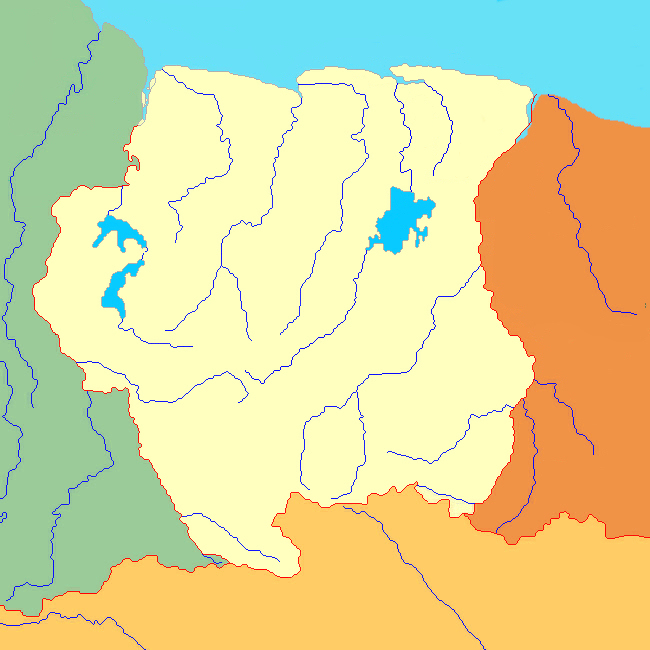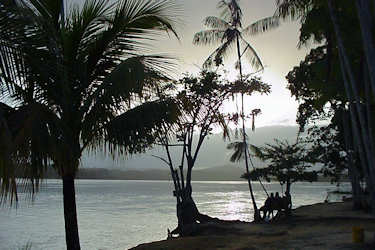Suriname

Historie
Settlement of Suriname dates back to 3.000 BC. The largest tribes were the Arawaks, a nomadic coastal tribe that lived
from hunting and fishing. They were the first inhabitants in the area. The Caribs also settled in the area and conquered the
Arawaks using their sailing ships. They settled in Galibi on the mouth of the Marowijne River. While the larger Arawak and
Carib tribes lived off the coast and savanna, smaller groups of indigenous peoples lived in the inland rainforest, such as the
Akurio, Trió, Warrau, and Wayana.
Beginning in the 16th century, French, Spanish, and English explorers visited the area. A century later, plantation colonies were
established by the Dutch and English along the many rivers in the fertile Guiana plains. Disputes arose between the Dutch and the
English. In 1667, during negotiations leading to the Treaty of Breda, the Dutch decided to keep the colony of Suriname which they
had conquered from the English. The English got to keep New Amsterdam, the main city of the former colony of New Netherland; which they
renamed it after the Duke of York: New York.
The planters of the colony relied heavily on African slaves to cultivate the coffee, cocoa, sugar cane and cotton plantations
along the rivers. Planters' treatment of the slaves was notoriously bad, and many slaves escaped the plantations.
With the help of the native South Americans living in the adjoining rain forests, these runaway slaves established a new and unique
culture that was highly successful in its own right. They were known collectively as the Maroons.
The Maroons often raided the plantations to recruit new members from the slaves and capture women, as well as acquire weapons, food
and supplies. To end hostilities, in the 19th century the European colonial authorities signed several peace treaties with different
tribes. They granted the Maroons sovereign status and trade rights in their inland territories.
Slavery in Suriname was abolished by the Netherlands in 1863, but the slaves were not fully released until 1873, after a mandatory
ten-year transition period during which time they were required to work on the plantations for minimal pay. As soon as they became truly
free, the slaves largely abandoned the plantations where they had worked for several generations in favour of the city,
Paramaribo.
As a plantation colony, Suriname was still heavily dependent on manual labour, and to make up for the shortfall, the Dutch brought in
contract labourers from the Dutch East Indies and India. In addition, during the late 19th and early 20th centuries, small numbers of
labourers, were brought in from China and the Middle East. Although Suriname's population remains relatively small, because of this
history it is one of the most ethnically and culturally diverse countries in the world.
In 1954, Suriname became one of the constituent countries of the Kingdom of the Netherlands, along with the Netherlands Antilles and
the Netherlands. In this construction, the Netherlands retained control of defense and foreign affairs.
In 1973, the local government, started negotiations with the Dutch government leading towards full independence, which was granted on
25 November 1975. The first President of the country was Johan Ferrier, the former governor, with Henck Arron as Prime
Minister.
In 1980, the government of Henck Arron was overthrown in a military coup led by Sergeant-Major Desi Bouterse. Another coup followed
five months later, with the army replacing Ferrier with Chin A Sen. These developments were largely welcomed by a population
that expected the new army-installed government to put an end to corruption and improve the standard of living. This was despite the
fact that the new regime banned opposition parties and became increasingly dictatorial.
The Dutch initially accepted the new government; however, relations between Suriname and the Netherlands collapsed when 15 members of
the political opposition were killed by the army on December 8, 1982, in Fort Zeelandia.
The 1987 constitution restored civilian government. New legislative elections were held in May 1991, and the New Front for Democracy
and Development, a coalition of several political parties, won a majority of seats. In September Ronald Venetiaan, a former
education minister and leader of the New Front coalition, was chosen as president. Venetiaan's coalition was narrowly defeated in
elections in 1996. He was succeeded by Jules Wijdenbosch, the presidential candidate of the National Democratic Party.
Despite the return to constitutional rule, Bouterse retained power through his control of the military.
I have visited Suriname in march 2004
These are the places i have seen
Paramaribo
Suriname rivier
Commewijne district
West Coast
Tapanahoni rivier
Marowijne rivier
Brownsberg Nature park
Please let me know when you're having questions.
i would be pleased to help you.
Things to do and other tips
